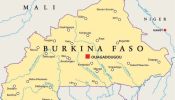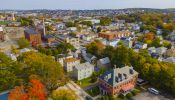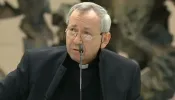Dear Bishop Perrier of Tarbes and Lourdes,
Dear Brothers in the episcopate and the priesthood,
Dear Pilgrims, dear Brothers and Sisters,
One hundred and fifty years ago, on 11 February 1858, in this place known as the Grotto of Massabielle, away from the town, a simple young girl from Lourdes, Bernadette Soubirous, saw a light, and in this light she saw a young lady who was "beautiful, more beautiful than any other". This woman addressed her with kindness and gentleness, with respect and trust: "She said vous to me", Bernadette recounted, "Would you do me the kindness of coming here for a fortnight?" she asked her. "She was looking at me as one person who speaks to another." It was in this conversation, in this dialogue marked by such delicacy, that the Lady instructed her to deliver certain very simple messages on prayer, penance and conversion. It is hardly surprising that Mary should be beautiful, given that—during the apparition of 25 March 1858—she reveals her name in this way: "I am the Immaculate Conception."
Let us now look at this "woman clothed with the sun" (Rev 12:1) as she is described for us in Scripture. The Most Holy Virgin Mary, the glorious woman of the Apocalypse, wears on her head a crown of twelve stars which represent the twelve tribes of Israel, the entire people of God, the whole communion of saints, while at her feet is the moon, image of death and mortality. Mary left death behind her; she is entirely re-clothed with life, the life of her Son, the risen Christ. She is thus the sign of the victory of love, of good and of God, giving our world the hope that it needs. This evening, let us turn our gaze towards Mary, so glorious and so human, allowing her to lead us towards God who is the victor.
Countless people have borne witness to this: when they encountered Bernadette’s radiant face, it left a deep impression on their hearts and minds. Whether it was during the apparitions themselves or while she was recounting them, her face was simply shining. Bernadette from that time on had the light of Massabielle dwelling within her. The daily life of the Soubirous family was nevertheless a tale of deprivation and sadness, sickness and incomprehension, rejection and poverty. Even if there was no lack of love and warmth in family relationships, life at the cachot was hard. Nevertheless, the shadows of the earth did not prevent the light of heaven from shining. "The light shines in the darkness …" (Jn 1:5).
Lourdes is one of the places chosen by God for his beauty to be reflected with particular brightness, hence the importance here of the symbol of light. From the fourth apparition onwards, on arriving at the grotto, Bernadette would light a votive candle each morning and hold it in her left hand for as long as the Virgin was visible to her. Soon, people would give Bernadette a candle to plant in the ground inside the grotto. Very soon, too, people would place their own candles in this place of light and peace. The Mother of God herself let it be known that she liked the touching homage of these thousands of torches, which since that time have continued to shine upon the rock of the apparition and give her glory. From that day, before the grotto, night and day, summer and winter, a burning bush shines out, aflame with the prayers of pilgrims and the sick, who bring their concerns and their needs, but above all their faith and their hope.
By coming here to Lourdes on pilgrimage, we wish to enter, following in Bernadette’s footsteps, into this extraordinary closeness between heaven and earth, which never fails and never ceases to grow. In the course of the apparitions, it is notable that Bernadette prays the rosary under the gaze of Mary, who unites herself to her at the moment of the doxology. This fact confirms the profoundly theocentric character of the prayer of the rosary. When we pray it, Mary offers us her heart and her gaze in order to contemplate the life of her Son, Jesus Christ. My venerable Predecessor, Pope John Paul II, came here to Lourdes on two occasions. In his life and ministry, we know how much his prayer relied upon the Virgin Mary’s intercession. Like many of his predecessors in the Chair of Peter, he also keenly encouraged the prayer of the rosary; one of the particular ways in which he did so was by enriching the Holy Rosary with the meditation of the Mysteries of Light. These are now represented on the façade of the Basilica in the new mosaics inaugurated last year. As with all the events in the life of Christ, "which she preserved and pondered in her heart" (Lk 2:19), Mary helps us to understand all the stages in his public ministry as integral to the revelation of God’s glory. May Lourdes, the land of light, continue to be a school for learning to pray the Rosary, which introduces the disciples of Jesus, under the gaze of his Mother, into an authentic and cordial dialogue with his Master!
On Bernadette’s lips we hear the Virgin Mary asking us to come here in procession so as to pray with simplicity and fervour. The torchlight procession expresses the mystery of prayer in a form that our eyes of flesh can grasp: in the communion of the Church, which unites the elect in heaven with pilgrims on earth, the light of dialogue between man and his Lord blazes forth and a luminous path opens up in human history, even in its darkest moments. This procession is a time of great ecclesial joy, but also a time of seriousness: the intentions we bring emphasize our profound communion with all those who suffer. We think of innocent victims who suffer from violence, war, terrorism, and famine; those who bear the consequences of injustices, scourges and disasters, hatred and oppression; of attacks on their human dignity and fundamental rights; on their freedom to act and think. We also think of those undergoing family problems or suffering caused by unemployment, illness, infirmity, loneliness, or their situation as immigrants. Nor must we forget those who suffer for the name of Christ and die for him.
Mary teaches us to pray, to make of our prayer an act of love for God and an act of fraternal charity. By praying with Mary, our heart welcomes those who suffer. How can our life not be transformed by this? Why should our whole life and being not become places of hospitality for our neighbours? Lourdes is a place of light because it is a place of communion, hope and conversion.
As night falls, Jesus says to us: "keep your lamps burning" (Lk 12:35); the lamp of faith, the lamp of prayer, the lamp of hope and love! This act of walking through the night, carrying the light, speaks powerfully to the depths of ourselves, touches our heart and says much more than any other word uttered or heard. This gesture itself summarizes our condition as Christians on a journey: we need light, and at the same time are called to be light. Sin makes us blind, it prevents us from putting ourselves forward as guides for our brothers and sisters, and it makes us unwilling to trust them to guide us. We need to be enlightened, and we repeat the prayer of blind Bartimaeus: "Master, let me receive my sight!" (Mk 10:51). Let me see my sin which holds me back, but above all, Lord, let me see your glory! We know that our prayer has already been granted and we give thanks because, as Saint Paul says in the Letter to the Ephesians, "Christ shall give you light" (5:14), and Saint Peter adds, "he called you out of darkness into his marvellous light" (1 Pet 2:9).
To us who are not the light, Christ can now say: "You are the light of the world" (Mt 5:14), entrusting us with the responsibility to cause the light of charity to shine. As the Apostle Saint John writes, "He who loves his brother abides in the light, and in him there is no cause for stumbling" (1 Jn 2:10). To live Christian love, means at the same time to introduce God’s light into the world and to point out its true source. Saint Leo the Great writes: "Whoever, in fact, lives a holy and chaste life in the Church, whoever sets his mind on things that are above, not on things that are on earth (cf. Col 3:2), in a certain way resembles heavenly light; as long as he himself observes the brilliance of a holy life, he shows to many, like a star, the path that leads to God" (Sermon III:5).
In this shrine at Lourdes, to which the Christians of the whole world have turned their gaze since the Virgin Mary caused hope and love to shine here by giving pride of place to the sick, the poor and the little ones, we are invited to discover the simplicity of our vocation: it is enough to love.
Tomorrow, the celebration of the exaltation of the Holy Cross brings us into the very heart of this mystery. At this vigil, our gaze is already turned towards the sign of the new covenant on which the whole life of Jesus converges. The cross is the supreme and perfect act of the love of Jesus, who lays down his life for his friends. "So must the Son of man be lifted up, that whoever believes in him may have eternal life" (Jn 3:14-15).
As proclaimed in the songs of the Suffering Servant, the death of Jesus is a death which becomes a light for the nations; it is a death which, in intimate association with the liturgy of atonement, brings reconciliation, it is a death which marks the end of death. From that day onwards, the Cross is a sign of hope, Jesus’ victory standard, "because God so loved the world that he gave his only Son, that whoever believes in him should not perish but have eternal life" (Jn 3:16). Through the Cross, our whole life gains light, strength and hope. The Cross reveals the whole depth of love contained in the original design of the Creator; through the Cross, all is healed and brought to completion. That is why life lived with faith in Christ dead and risen becomes light.
The apparitions were bathed in light and God chose to ignite in Bernadette’s gaze a flame which converted countless hearts. How many come here to see it with the hope—secretly perhaps—of receiving some miracle; then, on the return journey, having had a spiritual experience of life in the Church, they change their outlook upon God, upon others and upon themselves. A small flame called hope, compassion, tenderness now dwells within them. A quiet encounter with Bernadette and the Virgin Mary can change a person’s life, for they are here, in Massabielle, to lead us to Christ who is our life, our strength and our light. May the Virgin Mary and Saint Bernadette help you to live as children of light in order to testify, every day of your lives, that Christ is our light, our hope and our life!











